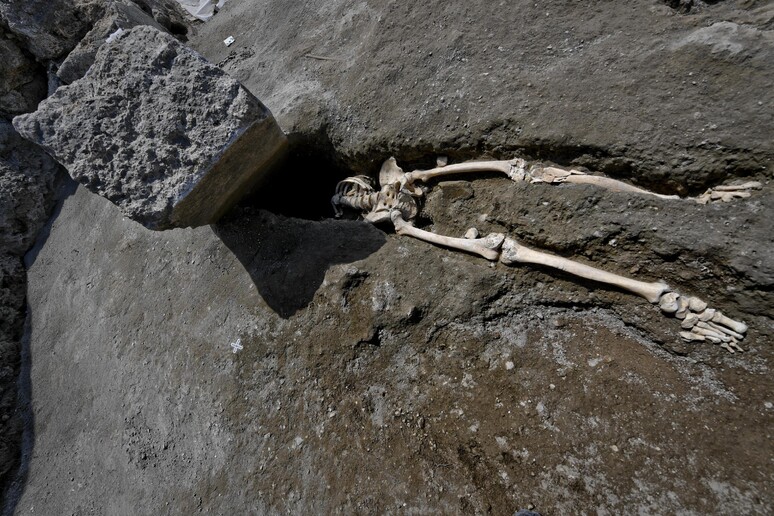The last man left fleeing
from the eruption of Vesuvius in 79 AD seems to have looked his
horrible end in the face as a 300-kilogram boiling mass hit him
head on.
In Pompeii - as an ANSA reportage of the recently opened
archaeological excavation documents - the digs have brought to
light another victim of the famous eruption.
The man was about 30-35 years old and suffered problems in
his leg leading to a limp. It may have been this that led to a
delay in his attempt to escape.
The discovery is a "dramatic and exceptional" one, said
Massimo Osanna, the archaeological director of the site, since
it was in that spot that 19th-century excavations and early
20th-century ones had already been conducted.
The discovery was in the area of new excavations, 'Regio V',
at the corner between Vicolo dei Balconi (the alleyway that the
Pompeii archaeological team brought to light just over a week
ago) and Vicolo delle Nozze d'Argento.
"We found it in an opening where there may have been a
fountain," the director said.
Over the centuries and possibly in part the 19th-century
excavations that took place in this part of the city, the ground
had collapsed on top of the man and thus it was impossible to
reconstruct his features using the plaster cast technique
created in the early 20th century by archaeologist Amedeo
Maiuri.
Some casts were instead able to be made around the skeleton,
which made it possible to understand how dramatic the last few
moment of the man's life must have been as he watched the lava
hit him, "dragging with it detritus, pieces of iron, copper and
pavement".
Experts say that the man must have ended up getting delayed.
His tibia, noted the team's anthropologist Valeria Amoretti,
shows traces - even 2,000 years later - of a very bad bone
infection which would have made any escape painful and
difficult.
When he decided to try to flee, the situation had already
arrived at a very bad point. The homes had partially collapsed,
two meters of lapilli had already been left in the alleyway, and
hot ash was raining down, engulfing the facades to the ground
level of the homes.
The limping man must have tried everything he could to leave
and managed to get into the street through a first-floor window.
But he did not go far.
He must have heard a deafening, tremendous thundering not far
behind him and may have given in to the temptation to look and
that proved his end.
Similar to the worst "catastrophe blockbusters", an enormous
mass possibly torn from the second level of one of the homes in
the street hit him in the chest, most likely beheaded him
immediately.
The archaeologists found him crushed on the ground, lying on
his back, the mass covering his shoulders, arms and his upper
torso. They noted that he may have been killed instantly, before
being crushed, suffocated by the miasma of the boiling mass.
The anthropologist noted that his skeleton shows several
fractures and some vertebrae seem broken. There are traces of
arthrosis on his spinal column.
Laboratory analyses, Osanna said enthusiastically, will use
systematic exams of his bones and DNA to better reconstruct
exactly what happened and more about the man himself, the last
of the Roman city to be wiped out by the eruption.
In any case, he noted, the remains of the limping man "is a
discovery that will add another important piece to the history
of Pompeii. This is the first time in 40 years that another
skeleton has been found and now we have the means and the
technology to learn a great deal about these remains. "
Culture Minister Dario Franceschini called it a "discovery
that will be known around the world", since "Pompeii is the
symbol of a history of Italian redemption and rebirth".
Meanwhile, work continues in Vicolo dei Balconi, the other
important discovery that happened a few days ago of four
balconies jutting out into the street, some with wine amphoras
still in the corners.
The mass still crushing the bust of the fleeing man will soon
be removed and "if we are lucky enough to find the skull we will
be able to reconstruct the physiognomy", Osanna said.
Some 2,000 years later, the tragedy of this nameless man will
serve as a monument to his memory.
ALL RIGHTS RESERVED © Copyright ANSA











